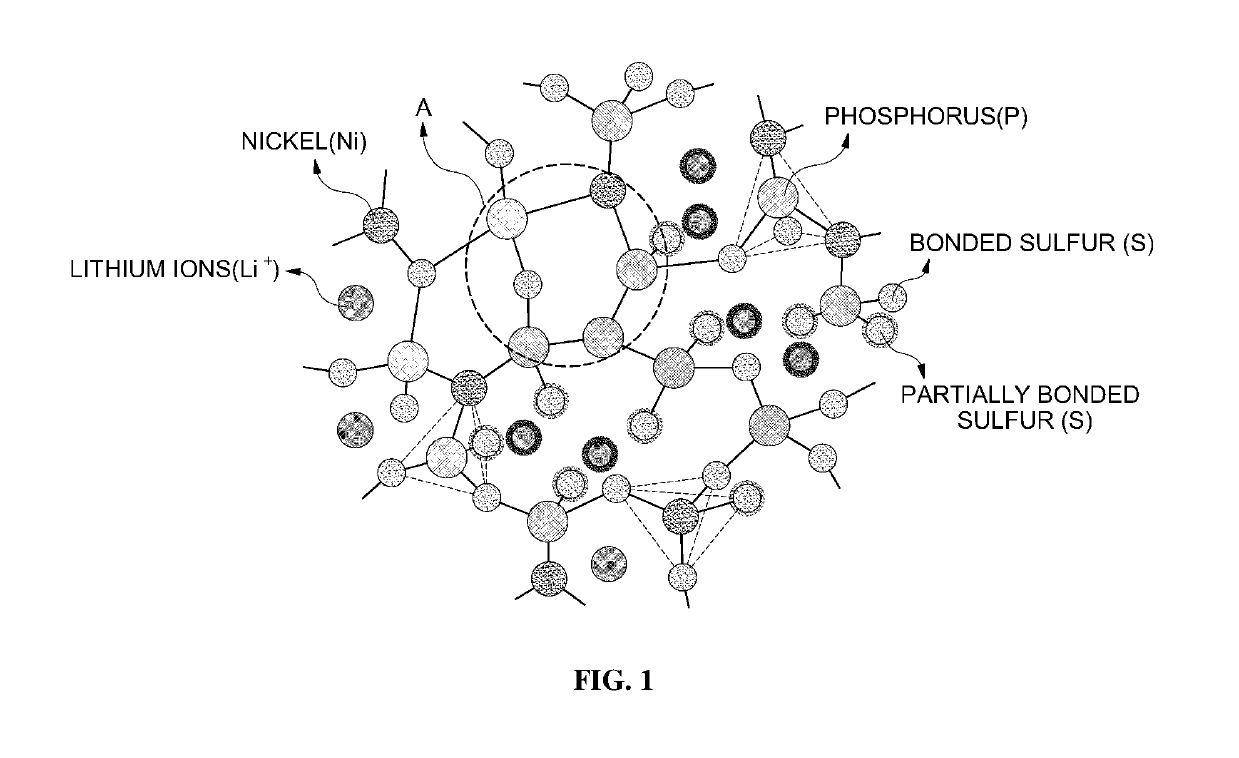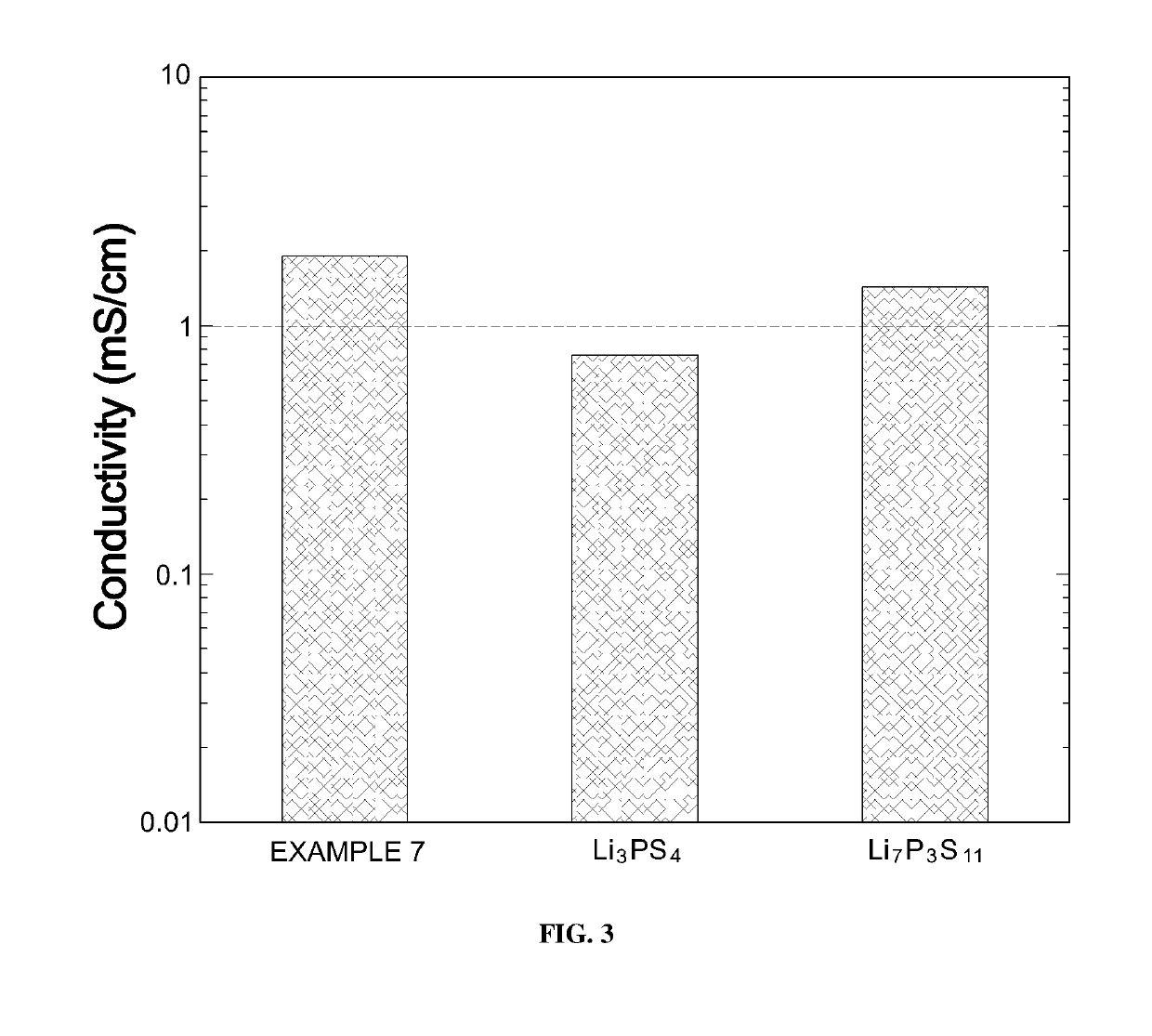Lithium ion-conductive sulfide-based solid electrolyte comprising nickel sulfide and all-solid state battery using the same
a technology of solid electrolyte and lithium ion conductive sulfide, which is applied in the direction of batteries, non-metal conductors, sustainable manufacturing/processing, etc., can solve the problems of limited composition ratios of sulfur (s), lithium (li), and phosphorus (p) exhibiting high lithium ion conductivity, and increase the risk of fire due to leakage of an electrolyte. , to achieve the effect of high lithium
- Summary
- Abstract
- Description
- Claims
- Application Information
AI Technical Summary
Benefits of technology
Problems solved by technology
Method used
Image
Examples
experimental example 1
Measurement of Lithium Ion Conductivity Depending Upon Element Composition Ratio of LNPS
[0070]LNPS preferably included lithium sulfide (Li2S), diphosphorus pentasulfide (P2S5), and nickel sulfide (Ni3S2) in a ratio of Y:(1−X)(100−Y):X(100−Y) by mol %, wherein X was 0.2 to 0.5, and Y was 60 to 80 mol %.
[0071]LNPS was prepared by varying X and Y as summarized in the following Table 1, and then, lithium ion conductivity thereof was measured.
[0072]
TABLE 1ExamplesXY [mol %]10.26020.27030.28040.36050.37060.38070.46080.47090.480100.560110.570120.580
[0073]An exemplary LNPS was prepared as follows.
[0074](1) Lithium sulfide, diphosphorus pentasulfide and nickel sulfide were weighed according to X and Y (mol %) of Table 1, and sufficiently mixed to prepare a mixture.
[0075](2) The mixture was ground using zirconia (ZrO2) beads. Here, a container for grinding was a planetary ball mill container. Grinding was continuously performed for eight hours at 650 rpm.
[0076](3) A vitrified or partially vit...
experimental example 2
Analysis of X-Ray Diffraction of LNPS
[0086]To see crystal structures of LNPSs according to Examples 7 to 9 of Experimental Example 1, X-ray diffraction analysis was performed. Results are illustrated in FIG. 4.
[0087]As shown in FIG. 4, it can be confirmed that most peaks are similar. However, it can be confirmed that, in the case of Example 8 which exhibited the greatest lithium ion conductivity, specific peaks B were exhibited when a diffraction angle (2θ) was 26±0.5°.
[0088]This is evidence showing that there was a slight difference between a crystal structure of Example 8 and crystal structures of Examples 7 and 9. It can be predicted that the lithium ion conductivity of Example 8 was increased by such a difference.
[0089]That is, LNPS according to Example 8 formed a specific structure due to nickel sulfide (nickel) included in a specific ratio, thereby exhibiting high lithium ion conductivity.
experimental example 3
Correlation Between Mole Ratio of Each Element Included in LNPS and Lithium Ion Conductivity
[0090]As described above, LNPS according to the present invention included lithium (Li), nickel (Ni), phosphorus (P) and sulfur (S), as constituent elements. Accordingly, correlation between a mole ratio among the constituent elements and lithium ion conductivity was obtained.
[0091]In the same manner as in Experimental Example 1, LNPS was prepared such that a ratio of lithium sulfide (Li2S):diphosphorus pentasulfide (P2S5):nickel sulfide (Ni3S2) was Y:(1−X)(100−Y):X(100−Y) by mol %. Here, X and Y may not be limited to specific numerals and may be various.
[0092]Lithium ion conductivity of the prepared LNPS was measured. Lithium ion conductivity values of LNPS according to mole ratios of lithium (Li), nickel (Ni), phosphorus (P) and sulfur (S) were represented as contour graphs. Results are illustrated in FIGS. 5 to 7.
[0093]As shown in FIGS. 5 to 7, in the following cases, LNPS showed high lith...
PUM
| Property | Measurement | Unit |
|---|---|---|
| mole ratio | aaaaa | aaaaa |
| mole ratio | aaaaa | aaaaa |
| mole ratio | aaaaa | aaaaa |
Abstract
Description
Claims
Application Information
 Login to View More
Login to View More - R&D
- Intellectual Property
- Life Sciences
- Materials
- Tech Scout
- Unparalleled Data Quality
- Higher Quality Content
- 60% Fewer Hallucinations
Browse by: Latest US Patents, China's latest patents, Technical Efficacy Thesaurus, Application Domain, Technology Topic, Popular Technical Reports.
© 2025 PatSnap. All rights reserved.Legal|Privacy policy|Modern Slavery Act Transparency Statement|Sitemap|About US| Contact US: help@patsnap.com



